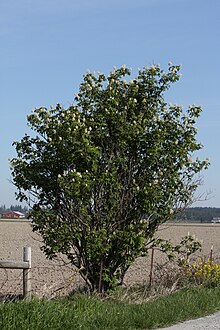Red-berried elder
| Sambucus racemosa | |
|---|---|
 |
|
| Scientific classification | |
| Kingdom: | Plantae |
| (unranked): | Angiosperms |
| (unranked): | Eudicots |
| (unranked): | Asterids |
| Order: | Dipsacales |
| Family: | Adoxaceae |
| Genus: | Sambucus |
| Species: | S. racemosa |
| Binomial name | |
|
Sambucus racemosa L. |
|
| Subspecies | |
|
|
Sambucus racemosa is a species of elderberry known by the common names red elderberry and red-berried elder.
It is native to Europe, northern temperate Asia, and North America across Canada and the United States. It grows in riparian environments, woodlands, and other habitats, generally in moist areas.
Sambucus racemosa is often a treelike shrub growing 2–6 metres (6.6–19.7 ft) tall. The stems are soft with a pithy center.
Each individual leaf is composed of 5 to 7 leaflike leaflets, each of which is up to 16 centimeters long, lance-shaped to narrowly oval, and irregularly serrated along the edges. The leaflets have a strong disagreeable odor when crushed.
The inflorescence is a vaguely cone-shaped panicle of several cymes of flowers blooming from the ends of stem branches. The flower buds are pink when closed, and the open flowers are white, cream, or yellowish. Each flower has small, recurved petals and a star-shaped axis of five white stamens tipped in yellow anthers. The flowers are fragrant and visited by hummingbirds and butterflies.
The fruit is a bright red or sometimes purple drupe containing 3 to 5 seeds.
The stems, roots and foliage are poisonous, and the berries can be toxic or cause nausea if eaten raw.
It has been used as a traditional medicinal plant by Native Americans, including the Bella Coola, Carrier, Gitksan, Hesquiaht, Menominee, Northern Paiute, Ojibwa, Paiute, and Potawatomi peoples. The uses included as an emetic, antidiarrheal, cold and cough remedy, dermatological and gynecological aid, and a hemostat.
...
Wikipedia
